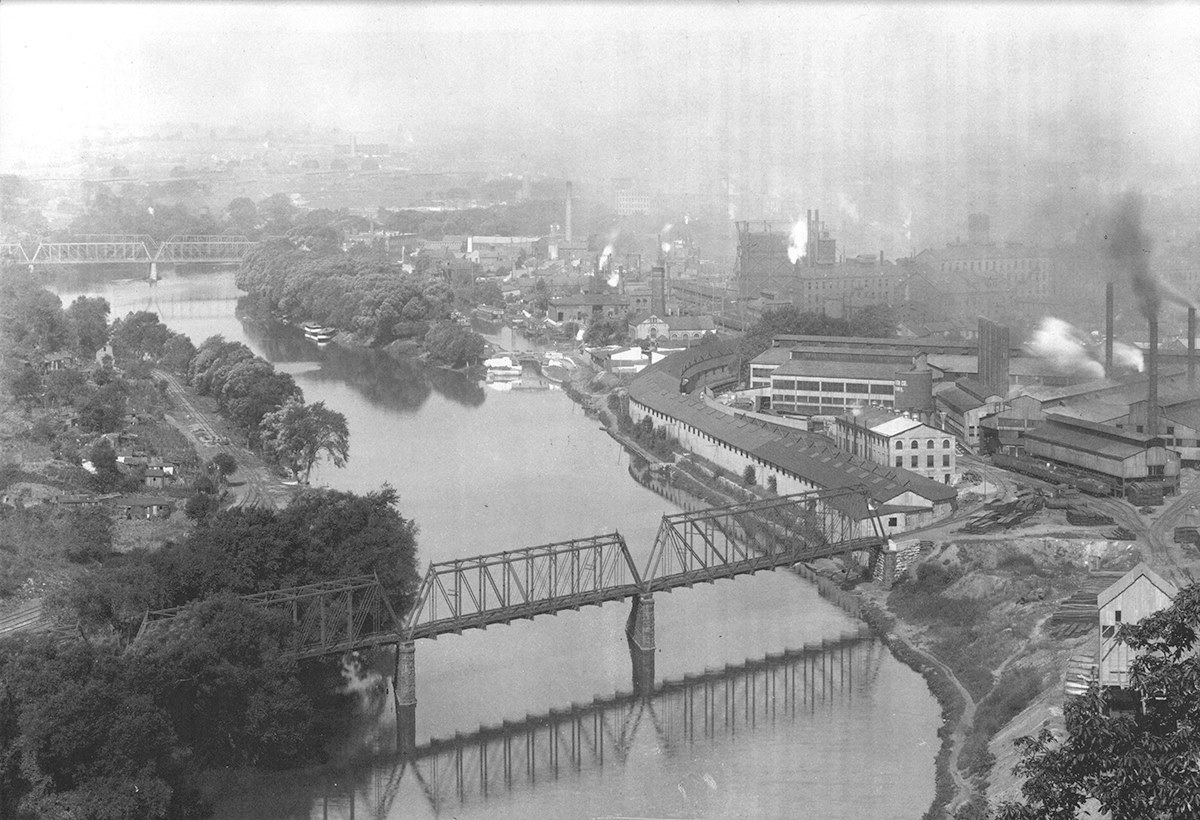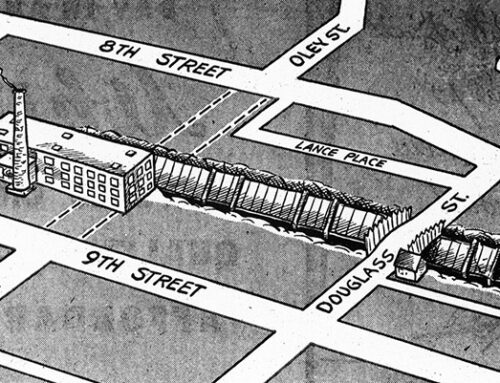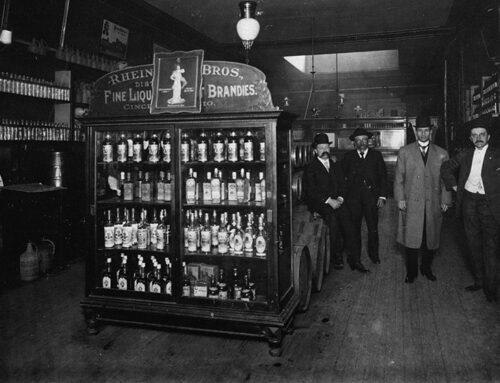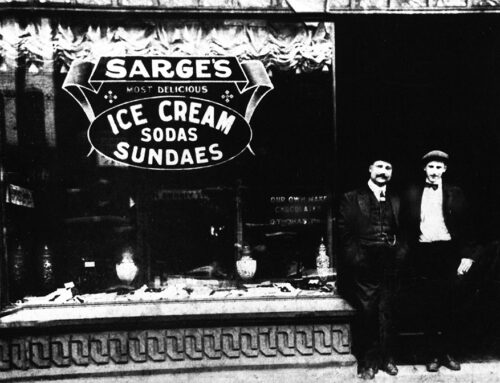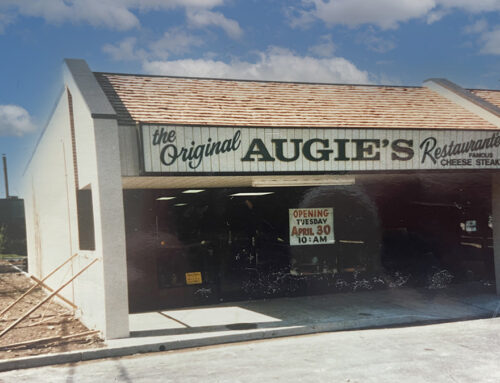As early as 1806 Berks County was noted as a great manufacturing center. The assessors’ lists of that year show there were 9 tilt hammers, 1 slitting mill, 8 furnaces and 20 forges in the iron industry. Among the other manufacturing plants were: 4 powder mills, 14 fulling mills, 2 hemp mills, 10 paper mills, 235 saw mills, 212 distilleries, 135 grist mills, 49 tanneries, 20 oil mills and 40 hat factories – the latter located in Reading.
The number of furnaces increased steadily until 1851, when there were 41 iron works. The forges declined rapidly being replaced by rolling mills as steam supplanted water as a motive power. At that time Berks County contained more iron works than any other county in the State and was not exceeded by any county in the union.
In 1836, the Reading Iron Company was a single rolling mill and nail factory, the hopeful venture of a group of men trading as Keim, Whitaker and Company, in the city of Reading.
The firm grew to huge proportions, to an industrial company with a dozen or more large plants, with 15 branch offices in all parts of the United States.
By 1936. the Reading Iron Company produced about 60 percent of the nation’s puddled Iron, dominating its field with a leadership born of sound experience and of principles as staunch and enduring as the iron it produced.
The phrase, “the world’s largest manufacturer of genuine puddled iron,” fails to tell all of the story of the Reading Iron Company. To understand it in its full significance, one must look behind the scenes at the vast network of properties, the thousands of acres of land, the huge manufacturing plants – and, above all, at the tradition of fine craftsmanship which was carried on in the Reading plants to constitute the firm’s body and spirit.
The Reading Iron Company was incorporated August 12, 1889, to operate all property and equipment of the former Reading Iron Works, purchased at a sheriff’s sale by the Philadelphia and Reading Railroad. It purchased from the Assignee of the old Reading Iron Works (which had failed in March of that year), the Tube Works, Scott Foundry, Sheet Mill and Forge. The operations were so comprehensive that they embraced almost every branch of the general Iron Manufacture. George F. Baer was named the first president, and remained in office until 1901.
Below: View from about 1900 of the Schuylkill River looking toward Reading from the hill at the foot of South 9th St.. The extensive Reading Iron Works was located in South Reading along the banks of the Schuylkill River.

The Keystone Furnace was acquired in 1889. The Keystone Furnace was located in the Northwest section of the City next to the Lebanon Valley RR Bridge. The present day Warren Street Bypass (Rt. 12) runs about parallel to the bridge today.
Below: Reading Company Lebanon Valley Bridge over the Schuylkill River and Reading Iron Company Keystone Furnace in the background in December 1938. (Hagley Museum).

The Crumwold Furnace at Emaus was purchased in 1895. The Oley Street Mills were built in 1896, and the Ninth Street Rolling- Mill (formerly the P. & R. Rail Mill) was added in 1896, and remodelled in 1899 and 1902. The Montour Rolling Mills at Danville, built in 1845, (and where the first T rails in the United States, were produced in October of that year) were acquired in 1895 and rebuilt in 1901. The Danville Puddle Mill was purchased in 1905. The Forge was rebuilt and equipped with powerful machinery and electric cranes in 1901-02. In 1923 the Charcoal Iron Plant was substituted for the production of charcoal iron skelp for boiler tubes.
Below: Reading Iron Company mill at W. Oley Street, 1926.

The Scott Foundry (originally built in 1854 and where cannon from nine inch to fifteen inch in caliber were made during the Civil War including the Brown Segmental Wire Wound Gun) was rebuilt in 1905-06.
The many separate departments of the company enabled the management to control the manufacture from the assembling of the raw materials to their conversion into the finished article, the largest output of which was tubular goods, consisting of wrought-iron pipe, plain or galvanized, for gas, steam and water, charcoal iron and steel boiler tubes for locomotive and other uses; oil well casing and tubing, hydraulic and line pipe, etc., ranging from one-eighth inch to twenty inch diameter.
The two Blast Furnaces had a total annual capacity of 180,000 gross tons of pig-iron and foundry-iron of superior quality, and the five distinct rolling-mill plants had an annual capacity of some 200,000 gross tons of finished rolled products, skelp, bar iron, etc., in the manufacture of which the mills consumed over 170,000 tons of their own puddle-bar. Cotton compressors, sugar mills, ordnance and general machinery were made at the Scott Foundry, and heavy marine, engine and general forgings, up to fifty tons, were made at the forge.
The Tube Works was the nucleus from which sprang this splendid aggregation of industrial plants. In 1836, Benneville Keim, George M. Keim, Simon Seyfert and James Whitaker, trading as Keim, Whitaker & Co., erected a rolling mill and nail factory, known as Reading Iron & Nail Works, at the foot of Seventh Street, between the Schuylkill Canal and the Philadelphia & Reading railroad (which had just been constructed). It was here that the first large stationary engine in Berks County was introduced for driving machinery. Bar iron was made in large quantities; also cut nails by twenty-six nail machines.
In 1846 the firm name was changed to Seyfert, McManus & Co. (Simon Seyfert, and his son Simon; John McManus, a railroad contractor, who had helped to build the Philadelphia & Reading railroad in the early forties; J. V. R. and Nicholas Hunter, Horatio S. Trexler, and a few other, were at various times members of the firm) and it so remained up to 1878, when the Reading Iron Works was incorporated. The first pipe-mill was built in 1848. Butt-weld pipe was made by the old tong process, drawing first one-half, and then the other, and lap-weld pipe was made shortly after, the edges of the skelp being then scarfed with sledge hammers. These methods were later greatly revolutionized. Charcoal iron tubes were made a few years later.
There had arisen from this modest beginning not only one of the largest independent tube works in the country, alone comprising nine mills, capable of producing 150,000 gross tons of tubular goods annually, but as well as the many other important plants or departments above mentioned, some of which comprised several establishments in themselves.
The company owned and operated 7,538 acres of Coal lands in Somerset County, known as the Somerset Coal department, which supplied the various departments with bituminous coal.
The company owned a large interest in the Pennsylvania Steel Company, one of the largest independent steel companies in the United States.
In August 1919, the Puddle Mill and Nail Plate Mill at Pottstown, with Nail Factory (in which 105 nail machines were installed) were acquired from the George B. Lessig Company by President Thomas.
In 1920, the Skelp and Nail Plate Mill, with 75 cut nail machines, at Birdsboro, were acquired from the E. & G. Brooke Iron Company, and in the same year the puddle mills and skelp mill formerly of the Susquehanna Iron Co., at Columbia, were all acquired.
The products of the Company had an unrivalled reputation at home and abroad, and there was a constantly increasing demand for them in all sections of the world. The utmost care was exercised by the managers, foremen and men to maintain the highest standard of excellence in the various lines of manufacture. It was the largest industrial enterprise in Berks County; in fact, one of the most important in Pennsylvania, and employed over six thousand men. The annual outlay for wages approximated nine million dollars, eighty per cent of which was paid in Reading.
The late George F. Baer was the Company’s first president until 1901 (when he was elected president of the Philadelphia & Reading Railroad Company) and much of its early success was due to him and the then vice-president and general manager, F. C. Smink (who had been business manager of the old iron works) and who succeeded Mr. Baer as president, serving as such until March, 1919, when he was elected Chairman of the Board; he died a year later. The late George Schuhmann was vice-president and general manager for some years up to August, 1919, and his services were particularly important in the rehabilitation of the old plants and the construction of new modern mills.
In 1923. due to the provisions of the U. S. Clayton Act and under the decree of the District Court, the Philadelphia and Reading Railroad Company transferred its control of the Reading Iron Company to the Philadelphia and Reading Coal and Iron Company,
On February 5, 1938 the Reading Chamber of Commerce learned indirectly that, the Philadelphia & Reading Coal & Iron Company directors ordered the immediate selling of the Reading Iron Company’s stock of finished products and materials in process to this company’s chief competitor.
Efforts by the Reading Chamber of Commerce to interest out-of-the-city investors and capital in restoring to operation the mills here, either through purchase or lease, were made over a period of many months early in 1938, but were unavailing. One proposal considered was to organize a new local company to take over some of the plants, on a lease-sale plan, the workers to take some of the capital stock and the new company to obtain a federal loan for operating expenses, but this plan also failed to materialize.
At the peak of its operations, the Reading Iron Company’s holdings, in land and equipment, aggregated a capital investment of approximately $12,000,000. Real estate was given a book value in the corporation’s balance sheets of approximately $1,000,000. Between 1928 and 1938, it was estimated that the corporation’s holdings and investments had depreciated to a book value of approximately $5,000,000. The capital stock of the company was $1,000,000.
The tube works, on South Seventh Street were rated as the largest investment, with the Roe puddling department on Oley Street, as second. The North Ninth street mills and their charcoal furnaces were third and the Keystone furnace plant fourth.
Below: South Seventh Street Iron Works.

Employing 7,500 men around the turn of the 20th century in its various plants, including mills out of Reading, the Reading Iron Company’s operations in Reading steadily dwindled in volume of employment. In the Spring of 1938, when its parent company, the Philadelphia and Reading Coal and Iron Company, went into reorganization proceedings under Section 77-B of the federal law, the last major operation, the Seventh street tube works, went out of operation. At that time estimates of the number of employees on payrolls in Reading located plants ranged from 1,500 to 1,700.
On Saturday, the last day of 1938, permits were obtained to raze 85 buildings at three plants of the Reading Iron Company, wiping out, with one exception, all of the remaining operations of the company in Reading. The exception was the nail mill at the South Seventh street pipe mills, the only unit in regular operation in 1938. The permits authorized the demolition of the huge pipe mills at the foot of Seventh Street in the Second ward, the North Ninth street mills in the Seventeenth ward, and the Oley street mills, two large plants in the Fifteenth ward. The Seventh street property was the equivalent of three city blocks in area; the North Ninth street tract nearly 45 acres and the Oley street plant area nearly as large.

